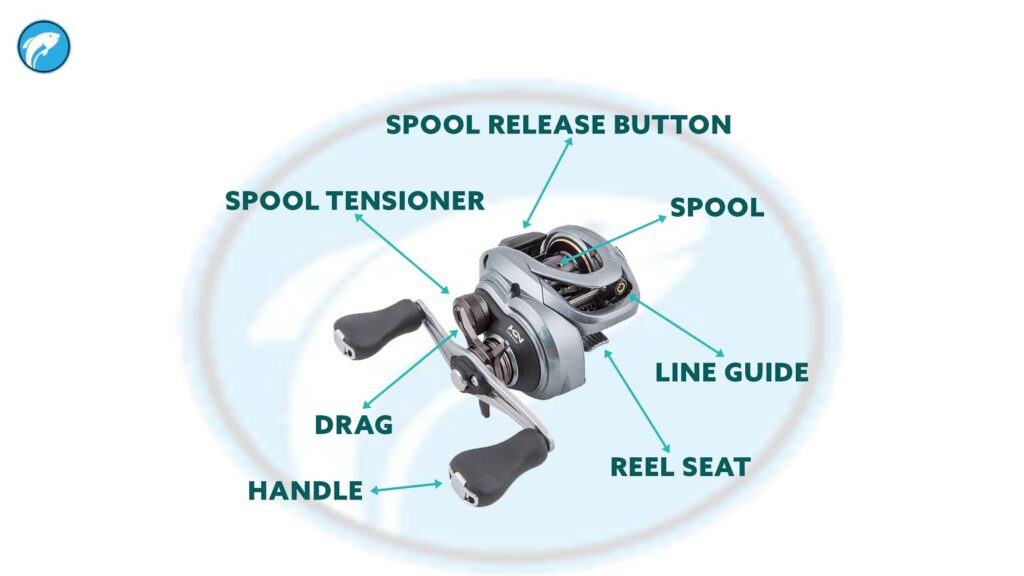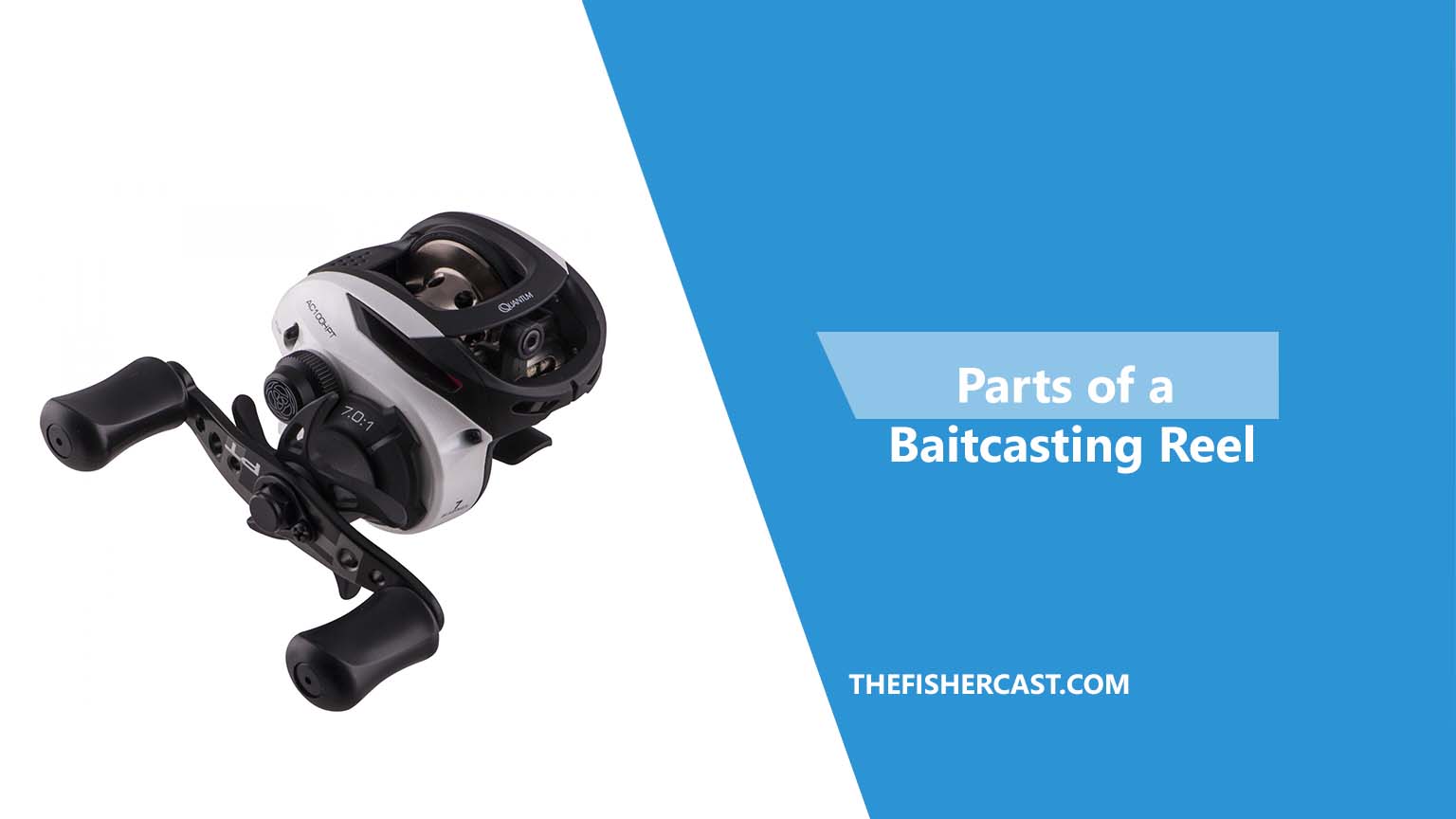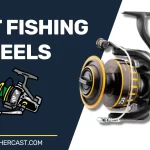Baitcaster reels are popular among anglers for several reasons, making them a good choice for fishing. Baitcasters offer excellent casting accuracy due to their design and mechanics. Baitcasters typically have larger line capacities and can handle heavier lines compared to other reels. Nevertheless, before experiencing the baitcasting reel one should be fully aware of the fishing reel parts.
In order to make you well-equipped with the knowledge of Baitcaster reel parts, this article is carefully curated. Let’s dig deep into parts of a baitcaster reel.

Contents
Handle: The Power Behind Reeling
The handle plays a pivotal role in a baitcasting reel, allowing you to reel in your prized catch effortlessly. Usually crafted from durable metal or comfortable plastic, it may feature a knob or grip for enhanced control. Connected to the reel’s drive shaft, the handle facilitates the rotation of the spool, ultimately reeling in your fishing line.
The handle of a baitcasting reel holds unparalleled significance as it serves as the primary means for controlling the reel during your fishing expedition. The handle’s size and shape directly impact its ease of use, while the grip determines your comfort level during long hours of angling. Depending on your preference, you can opt for metal handles, which are sturdy but may pose a slight risk of slipperiness, or plastic handles, which prioritize comfort despite being less durable. Additionally, some handles incorporate specialized knobs or grips for an even better grip experience.
By selecting the ideal handle for your baitcasting reel, you can enhance your overall fishing performance and make the most of your angling adventures.
The length of the handle is also important. A longer handle will give you more leverage, which can make it easier to turn the reel. However, a longer handle can also be more cumbersome to use. A shorter handle will be easier to use, but it will not give you as much leverage.
Here are some of the factors to consider when choosing a handle for a baitcasting reel:
- Size: The handle should be the right size for your hand. It should be large enough to grip comfortably, but not so large that it is cumbersome.
- Shape: The handle should have a comfortable shape. It should be easy to grip, and it should not be too smooth or too rough.
- Length: The handle should be the right length for your casting style. If you cast with a long rod, you will need a longer handle. If you cast with a short rod, you will need a shorter handle.
- Material: The handle should be made of a durable material. Metal handles are durable, but they can be slippery. Plastic handles are not as durable, but they are more comfortable to hold.
- Grip: The handle should have a good grip.
- The handle of a baitcasting reel must provide an easy grip, ensuring secure handling even when your hands are wet. It should offer an easy grip, ensuring secure handling even when your hands are wet.
The Spool: The Line Holder
The spool holds the fishing line securely in a baitcasting reel. It consists of either metal or plastic and features a lip on the edge, guiding the line onto the reel. The spool controls the amount of line released during casting. Baitcasting reel manufacturers commonly use aluminum or carbon fiber to make spools. Aluminum spools are more affordable but heavier, while carbon fiber spools are lighter and stronger, albeit more expensive. Some excellent baitcasting reels under $100 also offer good features.
The spool’s lip plays a crucial role in preventing the line from slipping off during casting. Additionally, a braking system equips the spool to prevent backlash, which can cause tangled lines during casting.
By understanding the importance of spools and considering their materials and features, anglers can enhance their fishing experience.
Key Considerations for Selecting the Perfect Baitcasting Reel Spool
Here are some of the factors to consider when choosing a spool for a baitcasting reel:
- Size: The spool should be the right size for your reel. It should be large enough to hold the amount of line that you need, but not so large that it is too heavy.
- Material: The spool should be made of durable material. Metal spools are durable, but they can be heavy. Plastic spools are not as durable, but they are lighter.
- Braking system: The spool should have a good braking system. The braking system should be able to prevent backlash, but it should not be too strong, or it will make it difficult to cast.
- Lip: The spool should have a good lip. The lip should be wide enough to guide the line onto the spool, but not so wide that it causes the line to slip off the spool.
Drag: The Line Tension Regulator
The drag mechanism on a baitcasting reel controls the amount of line released when a fish pulls on it. It plays a crucial role in preventing the fishing line from breaking during a fish’s fight. Manufacturers usually position the drag on the spool of the reel. This mechanism applies pressure to the spool, effectively preventing the line from slipping off. Adjusting the pressure on the spool allows you to control the amount of line released when a fish pulls on it. The drag holds significant importance among baitcasting reel parts, as it ensures the fishing line does not break when a fish is fighting. Incorrect drag settings may result in line breakage, leading to the loss of the fish.
Types of Drag:
There are two main types of drag: centrifugal drag and magnetic drag.
- Centrifugal drag: Centrifugal drag is the most common type of drag on a baitcasting reel. It uses centrifugal force to apply pressure to the spool. As the spool spins, the centrifugal force causes the brakes to apply more pressure, which helps prevent backlash.
- Magnetic drag: Magnetic drag uses magnets to apply pressure to the spool.
- The reel contains magnets positioned near the spool, and anglers can control them using a knob. When you turn the knob, it adjusts the strength of the magnetic field, thereby altering the amount of pressure applied to the spool.
Drag Adjustments:
Here are some of the factors to consider when adjusting the drag on a baitcasting reel:
- The size of the fish: The larger the fish, the tighter the drag should be.
- The type of fish: Some fish, such as bass, are more likely to break the line than other fish, such as trout. The drag should be set tighter for fish that are more likely to break the line.
- The type of line: The type of line that you are using will also affect the drag setting. The braided line is stronger than the monofilament line, so the drag can be set looser for the braided line.
A line guide is a metal ring that helps guide the line onto the spool of a baitcasting reel. It is usually located at the front of the reel, and it may have a roller on it to help reduce friction.
Line Guide: Smooth Line Management
The line guide is an important part of baitcaster reel parts because it helps to prevent the line from tangling when you cast. The line guide also helps to reduce friction, which can help to improve casting distance.
Types of Line Guides:
There are two main types of line guides:
- Open-face line guides: Open-face line guides are the most common type of line guide. They are open on one side, which allows the line to flow freely through the guide.
- Closed-face line guides: Closed-face line guides are less common than open-face line guides. They are closed on both sides, which helps to prevent the line from tangling.
Here are some of the factors to consider when choosing a line guide for a baitcasting reel:
- Size: The line guide should be the right size for your reel. It should be large enough to guide the line onto the spool, but not so large that it causes the line to tangle.
- Material: The line guide should be made of durable material. Metal line guides are durable, but they can be heavy. Plastic line guides are not as durable, but they are lighter.
- Type: The type of line guide that you choose will depend on your fishing style. If you are a spincaster, you will need an open-face line guide. If you are a baitcaster, you can choose either an open-face line guide or a closed-face line guide.
Brakes: Preventing Backlash
The brakes on a baitcasting reel are mechanisms that help prevent backlash, which is a tangle of line that can occur when you cast. There are two main types of brakes: centrifugal brakes and magnetic brakes.
Centrifugal brakes use centrifugal force to apply pressure to the spool. As the spool spins, the centrifugal force causes the brakes to apply more pressure, which helps prevent backlash. Centrifugal brakes are the most common type of brake on a baitcasting reel.
Magnetic brakes use magnets to apply pressure to the spool.
The magnets are positioned near the spool, and a knob on the reel controls them. When you turn the knob, it adjusts the strength of the magnetic field, thereby altering the amount of pressure applied to the spool. Magnetic brakes are a newer type of brake, but they are becoming increasingly popular.
Here are some of the factors to consider when adjusting the brakes on a baitcasting reel:
- The weight of the lure: The heavier the lure, the more brake you will need.
- The type of line: Braided line is more likely to backlash than a monofilament line, so you will need more brake when using a braided line.
- Casting style: If you are a beginner, you will need more brake than an experienced angler.
Cast Control Knob: Fine-tuning Your Casting
The cast control knob, also known as the spool tension knob, operates as a knob on a baitcasting reel that anglers use to control the amount of braking applied when casting. Anglers typically find it on the spool and can adjust it to different settings based on the weight of the lure being cast.
The cast control knob works by applying pressure to the spool as it spins. This pressure helps to prevent the spool from spinning too quickly, which can cause a backlash. You can adjust the amount of pressure applied by turning the knob.
Here are some of the factors to consider when adjusting the cast control knob:
- The weight of the lure: The heavier the lure, the more brake you will need.
- The type of line: Braided line is more likely to backlash than a monofilament line, so you will need more brake when using a braided line.
- Your casting style: If you are a beginner, you will need more brake than an experienced angler.
Thumb Bar/ Spool Release: Controlling Line Release
The thumb bar, also known as the spool release, empowers anglers to release the spool, allowing the line to be released. It forms one of the components of a baitcaster. Manufacturers typically position it on the side of the reel, and anglers operate it by pressing it with their thumbs. The thumb bar works by disengaging the spool from the drive shaft, enabling the spool to spin freely and releasing the line.
Here are some additional tips for using the thumb bar:
- When you are casting, press the thumb bar with your thumb just before you release the lure. Releasing the line smoothly and evenly will be ensured by this.
- When you are retrieving, release the thumb bar slowly so that the reel can reel in the line without backlashing.
- If you are experiencing backlash, try adjusting the brakes or the cast control knob.
Reel Foot: Attaching the Reel to the Rod
The reel foot is one of baitcaster parts that attach the reel to the rod. It is usually made of metal or plastic, and it has a screw or bolt that secures it to the rod.
There are two main types of reel feet: fixed reel feet and adjustable reel feet.
- Fixed reel feet: Fixed reel feet are the most common type of reel foot. They are permanently attached to the reel, and they cannot be adjusted.
- Adjustable reel feet: Adjustable reel feet are less common than fixed reel feet. You can adjust them to different positions, enabling you to fine-tune the balance of the reel on the rod.
Here are some of the factors to consider when choosing a reel foot for the best baitcasting reel:
- Size: The reel foot should be the right size for your reel and your rod. It should be large enough to secure the reel to the rod, but not so large that it makes the reel bulky.
- Material: The reel foot should be made of durable material. Metal reel feet are durable, but they can be heavy. Plastic reel feet are not as durable, but they are lighter.
- Type: The type of reel foot that you choose will depend on your fishing style. If you are a beginner, you may want to choose a fixed reel foot. If you are an experienced angler, you may want to choose an adjustable reel foot.
Tips for Using a Baitcasting Reel
- Practice casting in a safe area before you try it on the water.
- Use a light touch when casting.
- Keep your thumb on the spool to prevent backlashes.
- Adjust the spool tension to prevent overrunning.
- Use the right size line for the fish you are targeting.

Hi, I am David. I have founded THE FISHER CAST because I believe everybody deserve to do fishing smartly. I with my team are here to make this possible for our present and future generations by giving the best hands on practical experiences and reviews.


![10 Best Line Counter Reels [2023 Buying Guide & Reviews] Best Line Counter Reels](https://thefishercast.com/wp-content/uploads/2022/02/Best-Line-Counter-Reels-150x150.webp)
![10 Best Trout Spinning Reels [Reviews and Buying Guide 2023] Best Trout Spinning Reels](https://thefishercast.com/wp-content/uploads/2022/02/Best-Trout-Spinning-Reels-150x150.webp)
![10 Best Spinning Reels Under $100 [2023 Reviews] Best Spinning Reels Under 100](https://thefishercast.com/wp-content/uploads/2022/01/Best-Spinning-Reels-Under-100-150x150.webp)
![10 Best Spinning Reels [2023 Reviews] Best Spinning Reels](https://thefishercast.com/wp-content/uploads/2022/01/Best-Spinning-Reels-150x150.webp)

